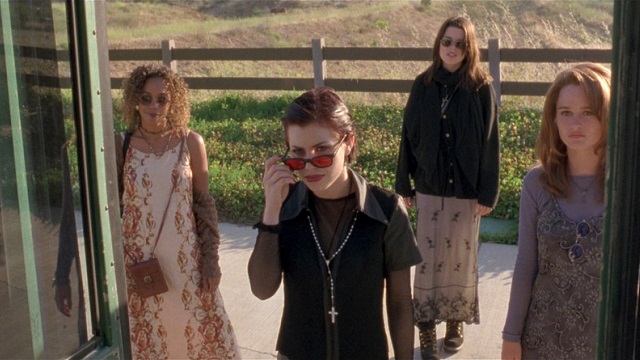If you were to create a list of the Most ’90s Movies Ever, The Craft would probably be in the top 10. If not top 10, then at least top 20. It’s sort of a nexus for everything that was happening in pop culture in the 1990s, and we’ll get into that. Most of all, it was practically a ritual at sleepovers of girls and gay boys everywhere.
In a way, The Craft was sort of like a teenage version of Matilda, but for goths and emotional teenagers. Fairuza Balk led a trio of outcasts who each had their own problems. Balk was a poor girl from an abusive household on the wrong side of the tracks who had a destructive sexual history with the quarterback. Neve Campbell was a mousey girl whose body was covered in scars. Rachel True was black in a mostly white school. These three initially form a wannabe coven that dabbles in homemade witchcraft, but that changes when they meet their fourth. Enter the new transfer student Robin Tunney, a girl with a suicidal past who quickly falls victim to the quarterback. Unlike the other three, Robin is a witch by blood, even if she doesn’t know it. Spells are cast, revenge is sought, and things go a little too far.
This was cinematic comfort food for teenagers in the 1990s. Sure, we knew we weren’t watching a masterpiece, but this had all the highlights of 1990s pop culture. The plot is the oh-so-90s deconstruction of high school cliques by creating a war between the A-Crowd and the B-Crowd (see also: Heathers, Daria, and Romy and Michelle). The 1990s had a very familial way of linking the supernatural and teen angst; corporations sent the message that they understood teenagers felt very alienated from their body and emotions, and they can make money from acknowledging that experience. And, the soundtrack is stuffed with dark alt-rock bands like Siouxsie and the Banshees, Our Lady Peace, and Portishead.
More than that, The Craft focused on the inner workings of a clique. The Craft hails from an era where teen movies were ensembles that created a larger system of well drawn characters. In 10 Things I Hate About You, Julia Stiles’ Kat was the main character but gave up a lot of screen time to the schoolmates courting her sister. Cruel Intentions created a tight system of teenagers plotting and scheming around and against each other. Arguably, The Craft could be boiled down to Fairuza Balk vs Robin Tunney, but all four characters have a relatively equal amount of screen time through the first two acts.
Something I think that we’ve lost along the way is the ability to make movies about groups without being about groups of superheros. Modern teen movies have taken a note from modern indie movies and have narrowed their focus from large groups to one or two subjects in a complicated world. They have a shallow depth of field creating beautiful character studies but alienating those characters against a backdrop that seems besides the point. Whether its dramas or comedies (The Edge of Seventeen, Me Earl and the Dying Girl, Dope, or The Fits), or action movies (The Hunger Games, The Allegient Series), a modern trend in teen movies is to focus on the experience of one or two people.
Director Andrew Fleming had gotten his start directing the mid-range-for-horror-budget Bad Dreams, wrongfully seen as a knockoff of the Nightmare on Elm Street series. It showed Fleming to have a brutal sense of humor and showing no restraint when it came to pushing the horror elements. Both are on display by the end of The Craft, which eventually gets around to being a special effect-driven extravaganza. But, Fleming has a style that’s remarkably skilled yet mostly absent of a signature. From Bad Dreams to The Craft to Threesome to Hamlet 2 to Dick to Nancy Drew (all of which Fleming has screenwriting credits on), there’s no single element where you can say “That’s an Andrew Fleming film.”
And yet, without any defining flair, The Craft is a good movie. Look at the framing in the screen grab. It captures four separate people in a single shot through a bus door AND positions them like they represent the four cardinal directions (North, South, East, West). The bus driver tells the girls to watch out for the weirdos, and they reply, “We are the weirdos.” Oh, and by weirdos, they totally mean they’re bisexual. Or, at least closeted bisexuals. That whole subplot with the quarterback takes a backseat to the “tensions” between Balk and Tunney. Plus, those outfits. Mallory Ortberg over at The Toast does a full reading of how The Craft is a campy thinly-coded lesbian movie.
Much like Buffy and The Fits, The Craft uses a supernatural element to tackle real world issues without going full-on Degrassi. The campy attitude it possesses achieves the seemingly impossible task of opening discussion by not making a big deal out of its issues of identity, self-image, sexuality, sexual assault, class and racial difference, suicide, and traumatic family history. To this day, it remains electric film making that feels a bit daring and risky.

